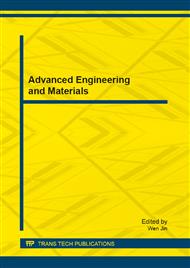p.194
p.200
p.204
p.212
p.216
p.223
p.227
p.230
p.236
Study of the Effect of MoS2 and PTFE Based Coatings on Adhesive Wear of Stainless Steel
Abstract:
this paper, the adhesive wear characterization of MoS2, PTFE and mixture of MoS2 and PTFE films coated on stainless steel substrate, i.e. SUS440C, have been studied. The films were deposited by dry spray techniquecommercially available domestically. The films properties which are surface hardness, film thickness, surface roughness and adhesion strength were investigated. The thickness and the surface hardness of the films were approx. 7, 6.8 and 6.2 µm and 0.1,0,8 and 0.4GPa for MoS2, PTFE and the mixture of MoS2 and PTFE, respectively.The surface roughness of MoS2, PTFEwerefound to be similar with the value of Ra of approx. 0.302-0.303 µm. The mixture of MoS2 and PTFE showed smoother surface with the surface roughness (Ra) of approx.0.260µm. The PTFE film has shown better adhesion strength with higher critical load for first failure and full delamination. However, the failure pattern observed suggested lower severity of surface damage.Theresults fromtribologicaltests between the coated SUS440C ball and the SUS304 discshowedstrong effect of the coating on adhesive wear behavior of the contacting systems.For MoS2coated surface, the coatingsurface peeled offgraduallyuntil the surface ofthe substrate was revealed. Whereas, the PTFEcoated surface had delaminated immediately once in contact resulting in plate liked wear debris.The mixture ofMoS2 andPTFE haslower thefriction coefficient compared to the individual coating. Thewearbehavior found on the mixture of MoS2 and PTFE coated surface had similar characteristic to those found on surfacecoatingwithMoS2. It also showed lower wear occurrences with better appearance due to tearing wearat the edges of the worn suggesting better load capacity of the mixed film than the individual PTFE coating.
Info:
Periodical:
Pages:
216-222
Citation:
Online since:
February 2013
Authors:
Keywords:
Price:
Сopyright:
© 2013 Trans Tech Publications Ltd. All Rights Reserved
Share:
Citation:


